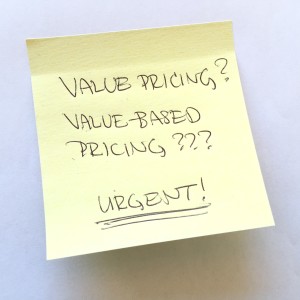
Abstract: Value-based pricing or value pricing refers to strategic pricing, where you price your service offering (goods/services) based on the value of it for your customers, as opposed to its production cost or market price. The benefits of value pricing compared to traditional pricing can for the buyer/customer include a closer match between actual use value and the investment required. For the seller it can provide a means to differentiate from competitors. The value of value pricing for the buyer can include a more efficient use of resources. For the seller it can result in higher revenues and improved profitability.
Are you asking yourself what value-based pricing or value pricing is and if you should be interested in it? Are you interested in entering strategic pricing? Since you are reading this, the likely answer to the question is ‘yes’. That’s good! In most of the value sales trainings that I give to sales and business executives, managers and experts, I include a session or module on value-based pricing or value pricing. Let’s go through what value-based pricing or value pricing (hereinafter referred to as value pricing) is, and why this could be of interest for you too.
Pricing principles
Traditionally companies price their market offerings based on what it costs to produce, plus a margin. This is called cost-based pricing. The upside is that the price is easy to calculate. The downsides include that the production cost (plus the margin) does not reflect the true value of it for the customer, which can mean that you are leaving money on the table. Additionally, the buyer/customer might argue that they can make it cheaper themselves, and starts demanding huge discounts, which mean lower margins and profit for you. Another popular pricing principle is market-based pricing, which refers to pricing your offering based on the prices on the market. A sub-form of that is skimming, which relates to pricing your offering based on what you believe the market can tolerate. Another variant of market-based pricing is setting your price point e.g. just below your competitors – if you can afford doing that. The downsides of market-based pricing include e.g. that you are following the market, as opposed to leading the market. Value pricing refers to pricing your market offering based on the value of it for your customer. The advantages of value pricing include that it should reflect the true value of your offering to your customer. This should result in a fair – or why not even an excellent – deal for both. The challenges related to value pricing include that it demands more from you and your team. Usually, however, the extra work required pays off big time.
Value approach in business
Although sales, marketing and purchasing have developed considerably in companies during the last decades, strategic pricing management has not really kept up with their pace. Selling and sales management have undergone a change. Nowadays many companies are willing to move to value-based selling and value sales – although few actually succeed in this undertaking, but that’s another story, which I will discuss more about in another insights/blog post. Running a successful business that is profitable also in the long run means managing your business professionally – in a way that focuses on helping to add value to your customer, and to capture value to your business. This entails not only selling in a value-based manner, but also entering the path of value pricing.
Value pricing requires knowing your customer
Is value pricing a gimmick or a fad? No. Value pricing is part of professional pricing and value-based business management aimed at helping both you and your customer. The benefits of value pricing for your customer include that there is a closer match between what they pay and what they actually get. Of course, here we need to remember that not all purchases are the same. Some customers value some purchases higher than others. This means that as a seller you have to analyze, calculate, substantiate, and argue for the value for your customer in a way that makes sense to your customer, and to you. In other words, we are seeking to create win-win situations.
Benefits and value of value pricing
The benefits of value pricing for the seller – i.e. for you – are invaluable. Not only does value pricing focus on helping you get a higher price for your offering, but it can also provide a means of differentiating yourself and your business from your competitors. When implemented correctly, value pricing can help you sell your product/service at a higher price. The value of value pricing for you can be that it can help you run your business in a more profitable manner, and help you build stronger customer relationships.
Wondering where to begin?
Interested but not sure how to proceed or where to begin? Not a problem, we can help you. There are different ways to go about it. Both Paul Viio and the Value Business Academy focus on helping build sustainable and profitable businesses, and provide extensive support such as ’business 2.0 consulting’, training and workshops also in value pricing – both as online and in-company trainings. If you prefer, you can also book Paul Viio though leading executive education or business training organizations. Additionally, we also collaborate with other professionals in pricing management. Let’s discuss your needs and situation so we can help you master value pricing. Don’t hesitate to contact me.
About: Dr. Paul Viio is a professional sales & business trainer, consultant, advisor, and he holds two professorships in selling and sales management at distinguished universities and business schools.




